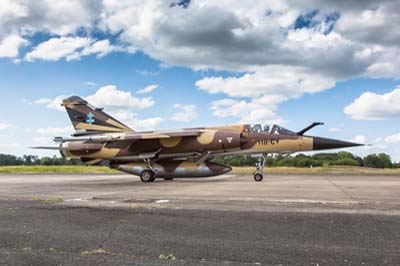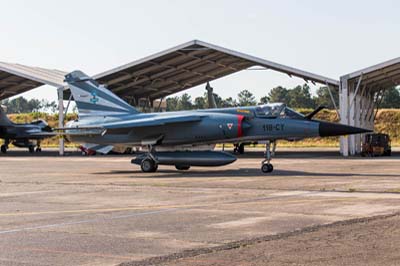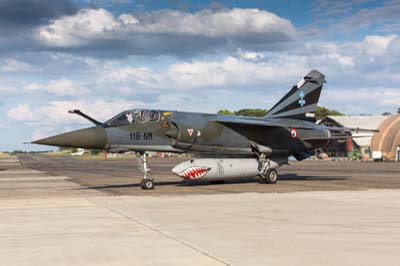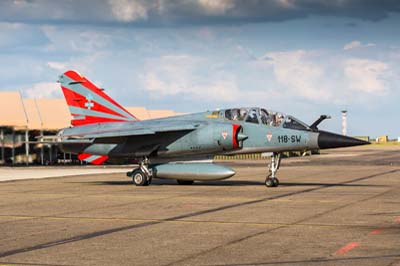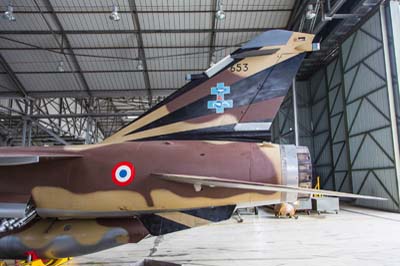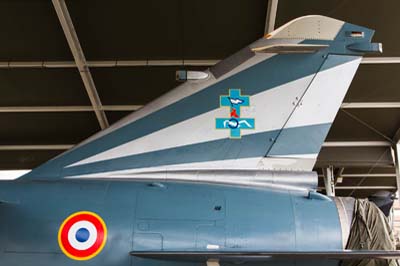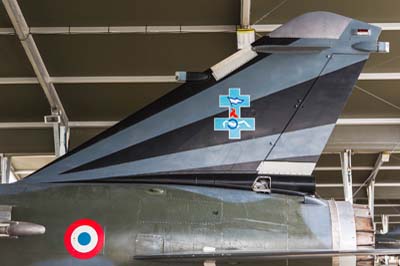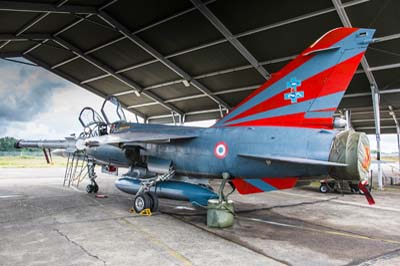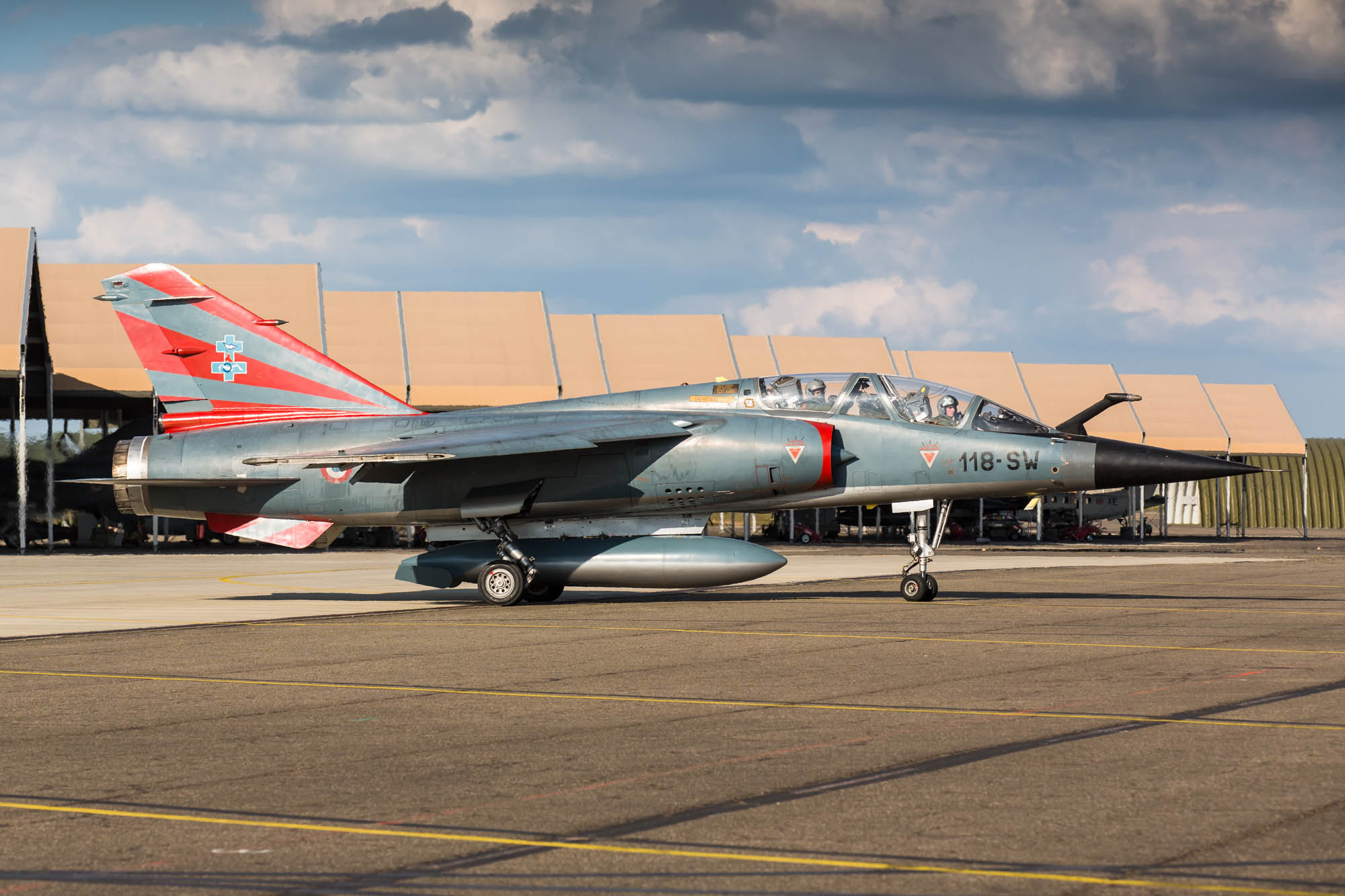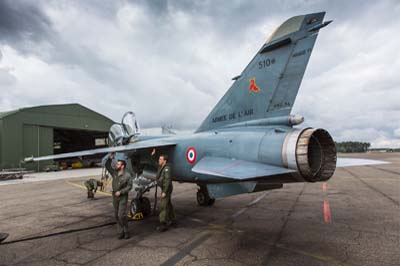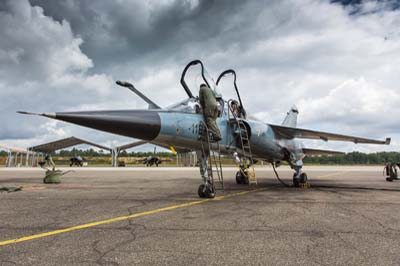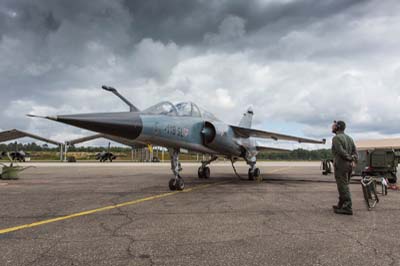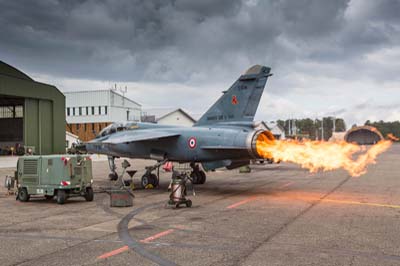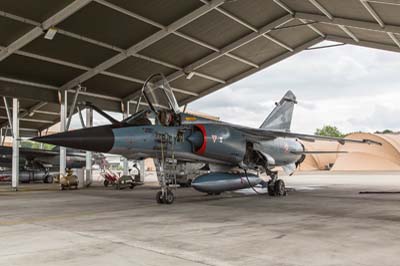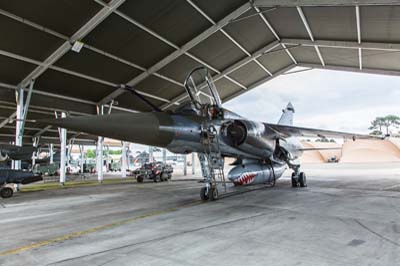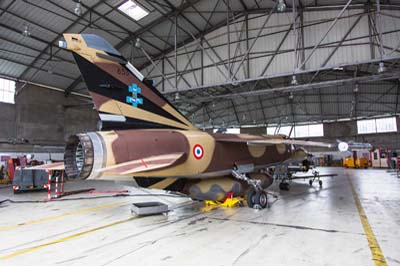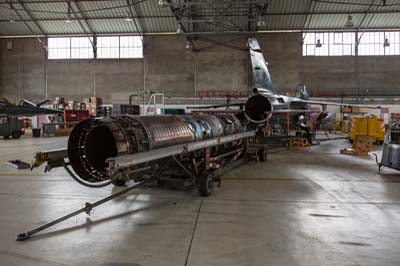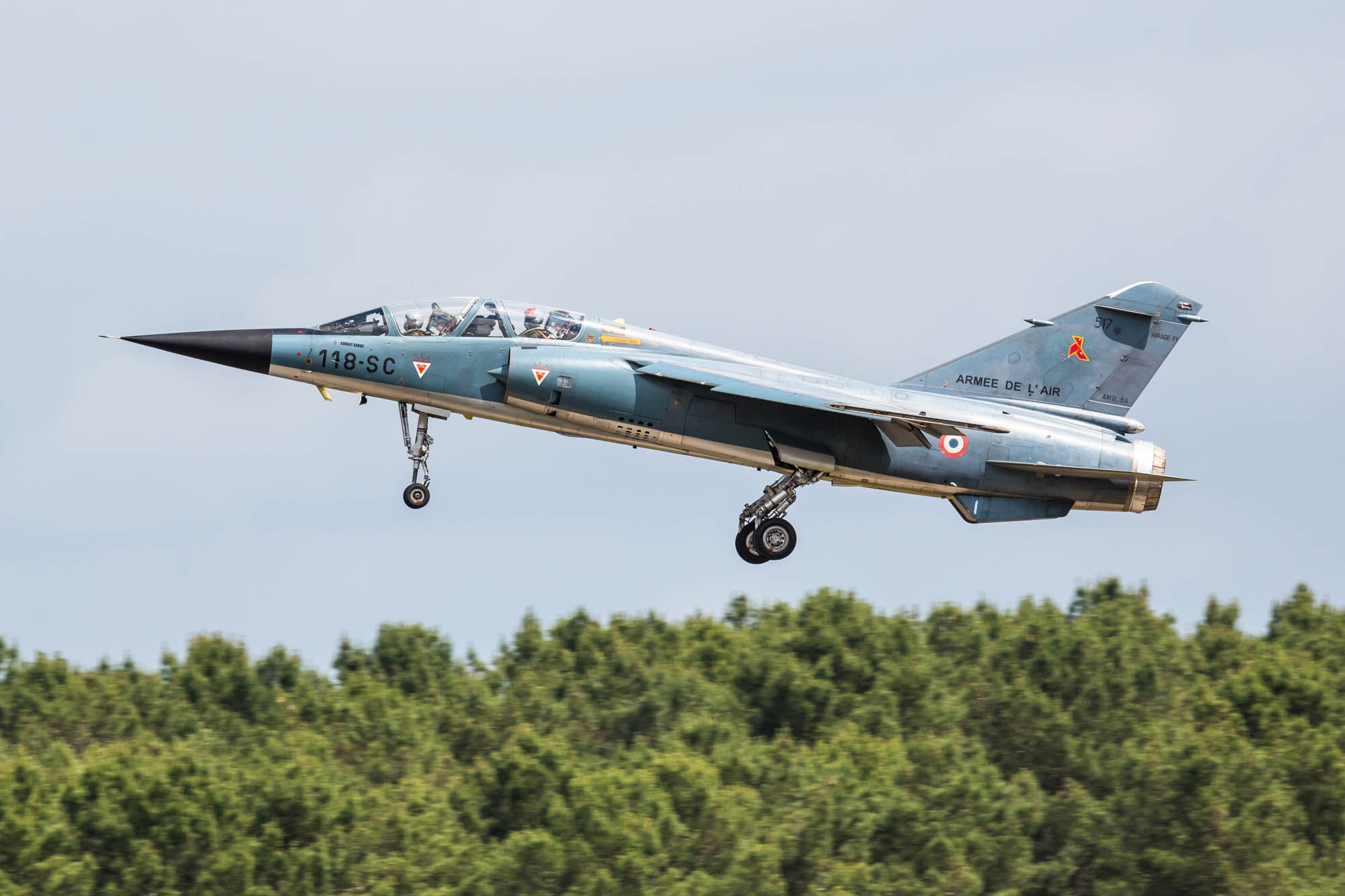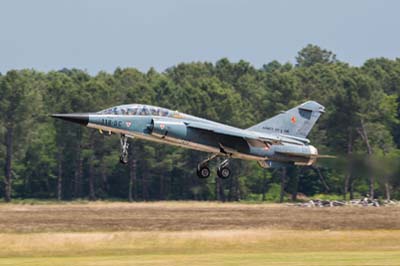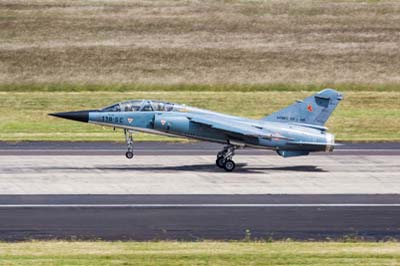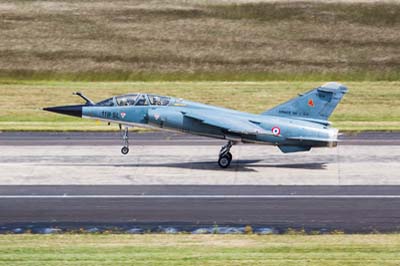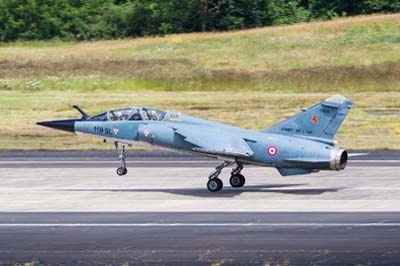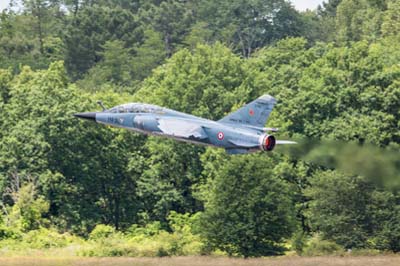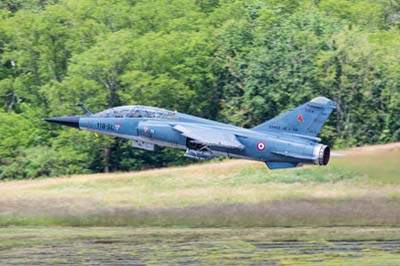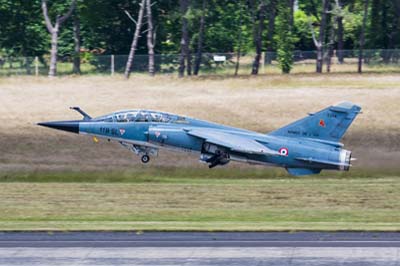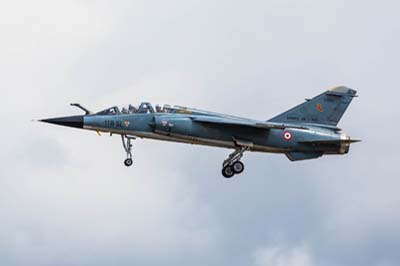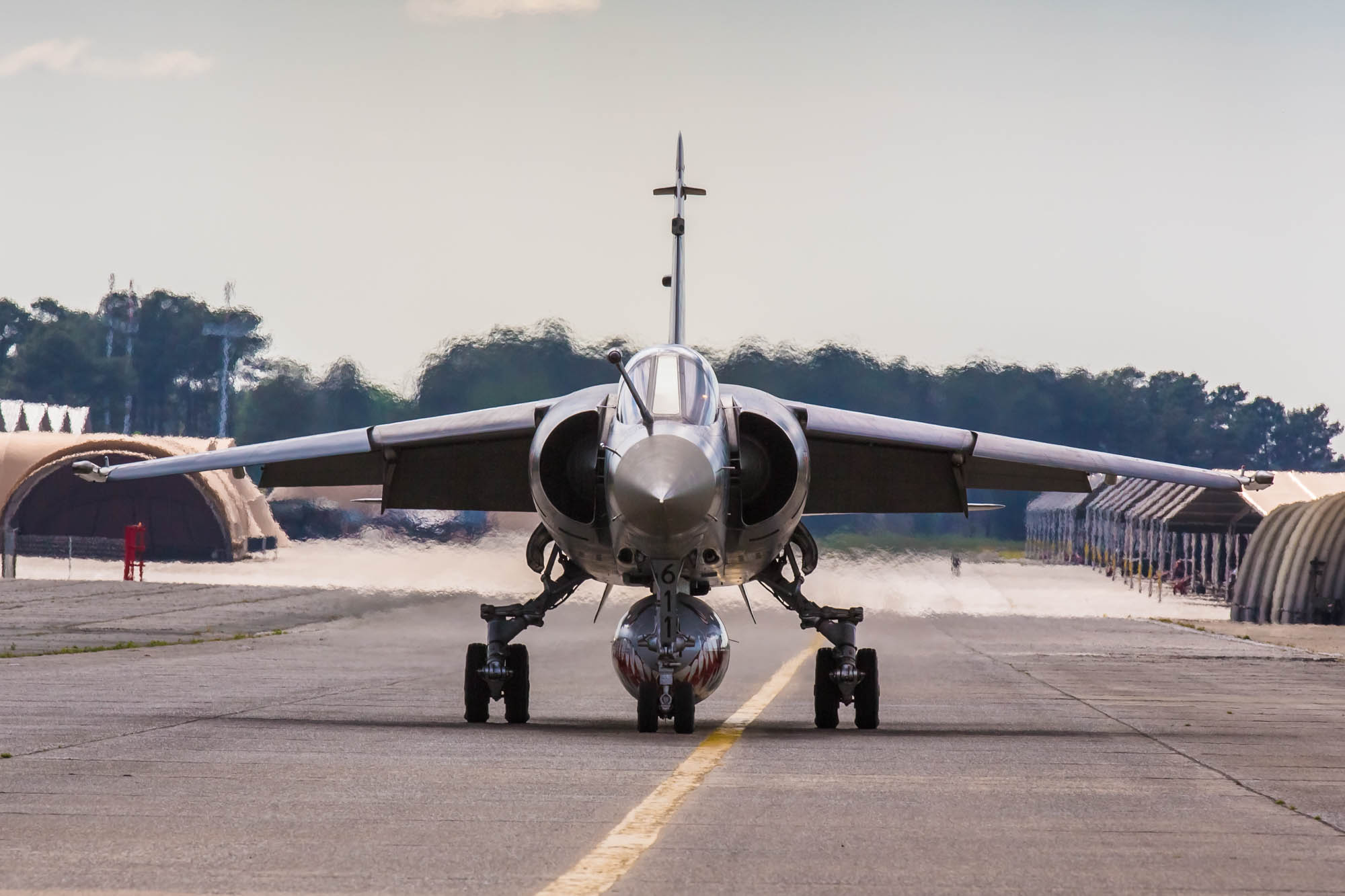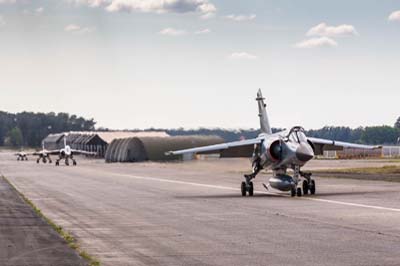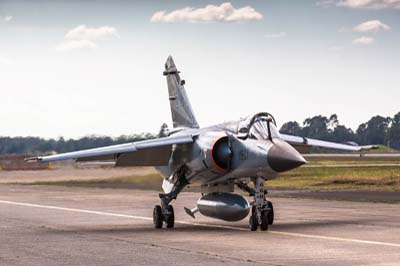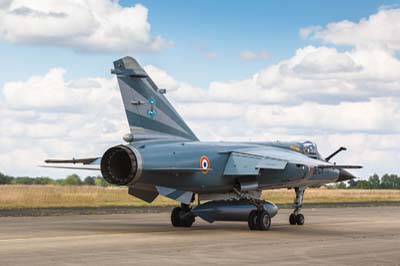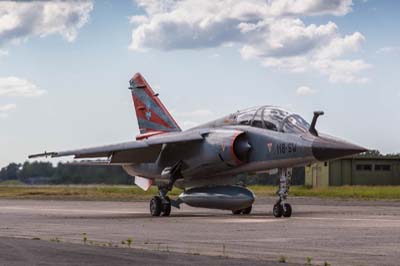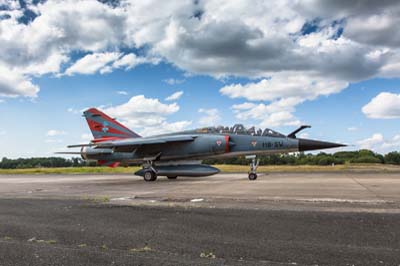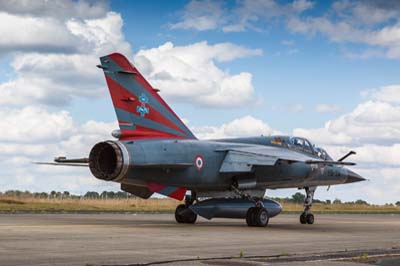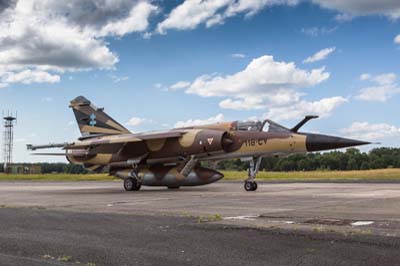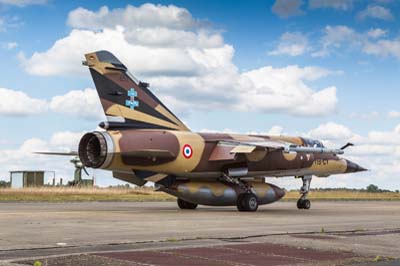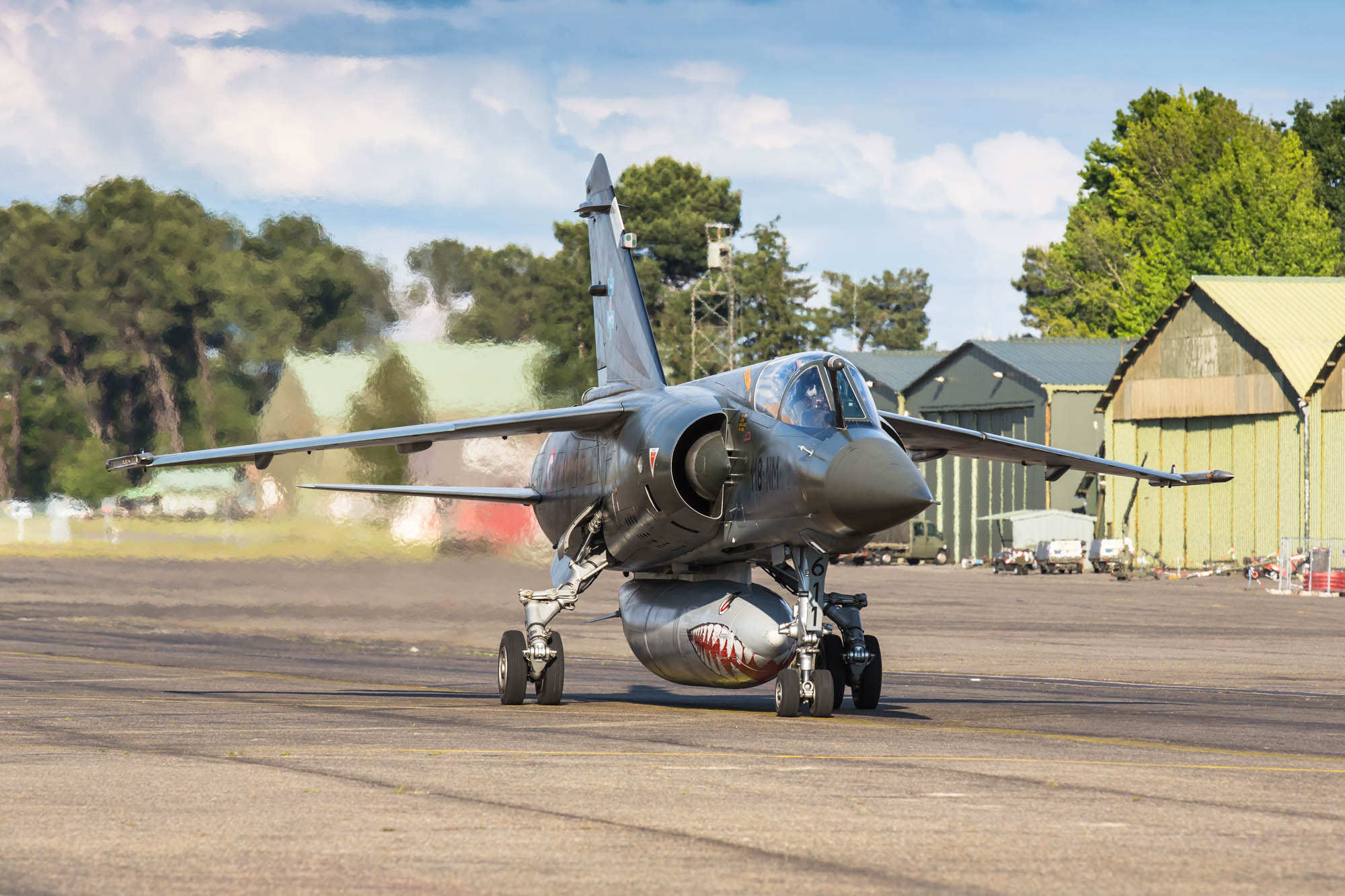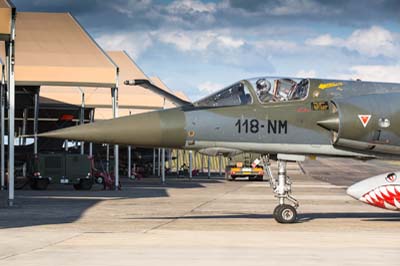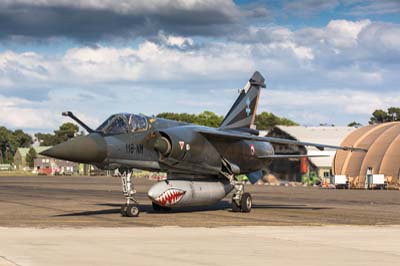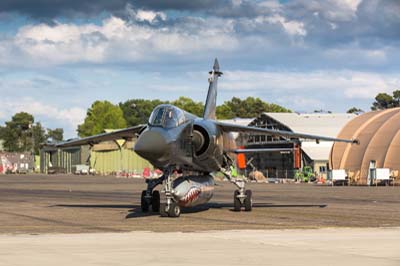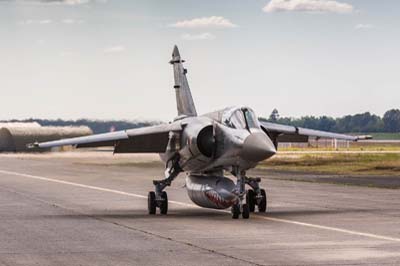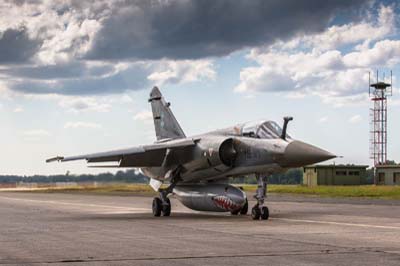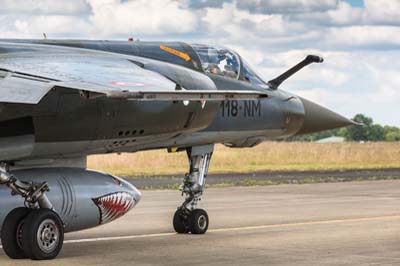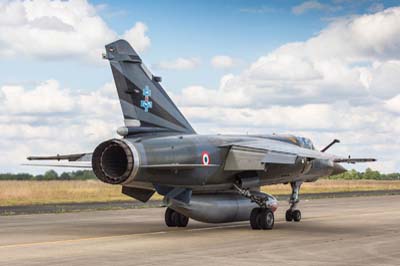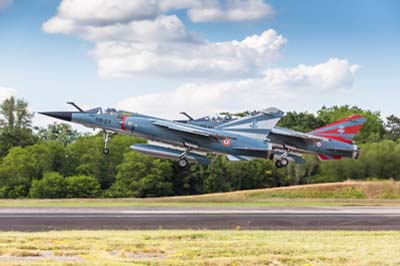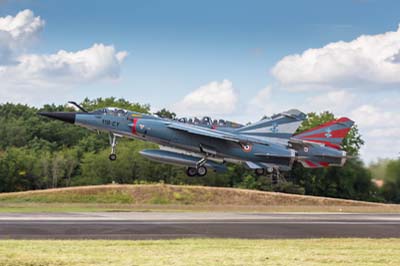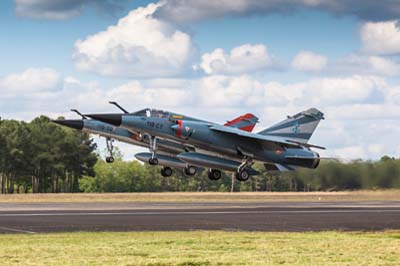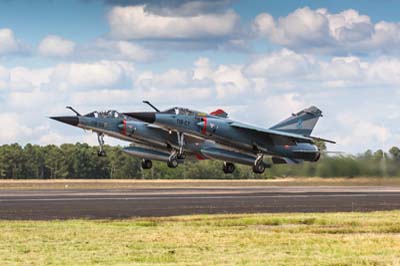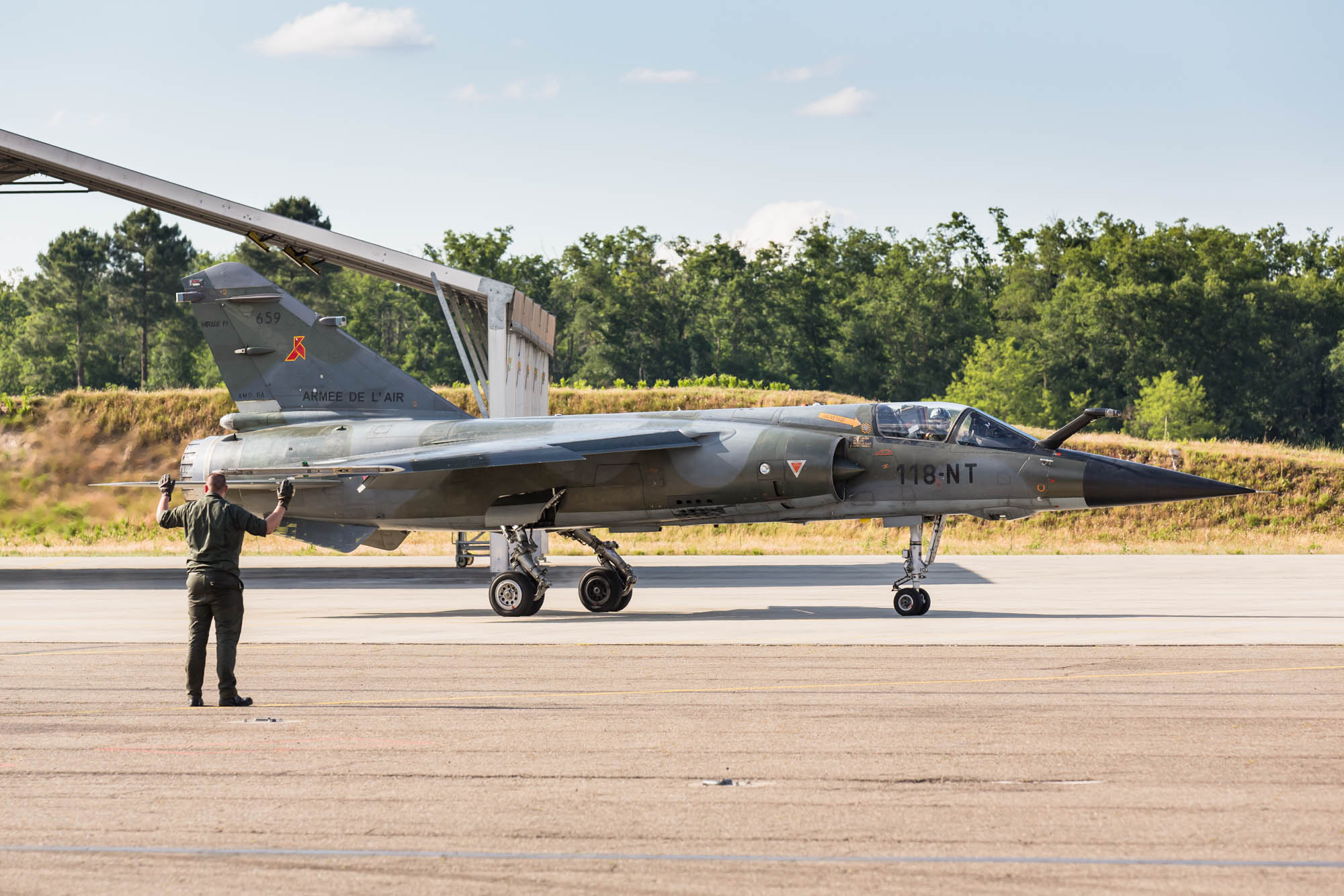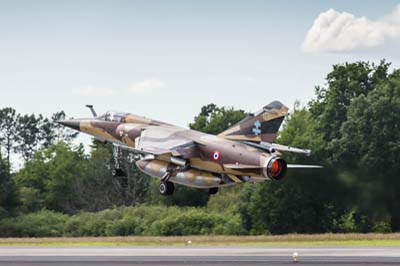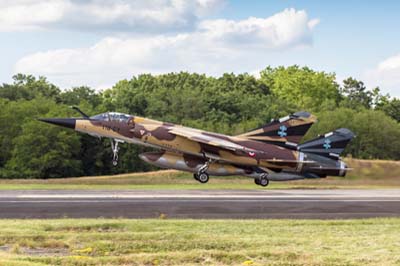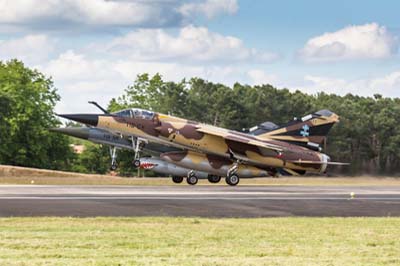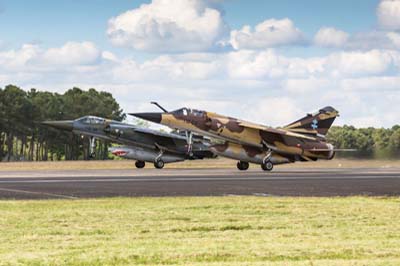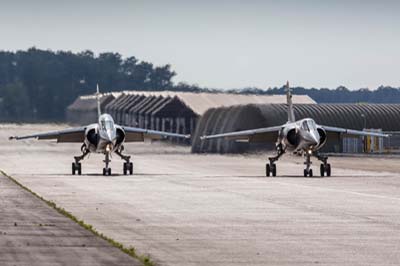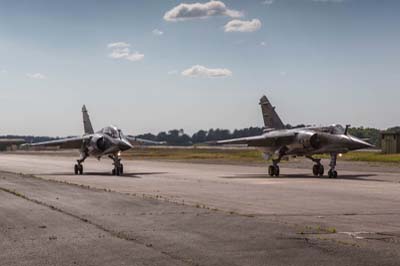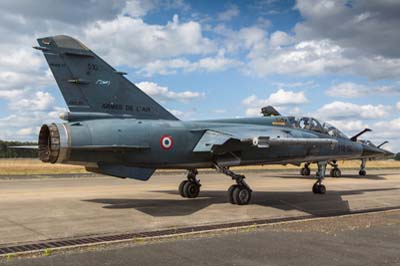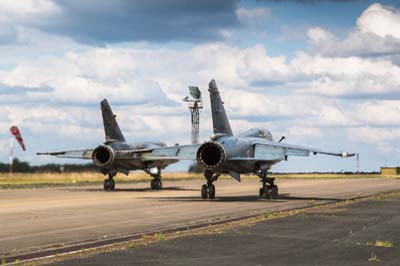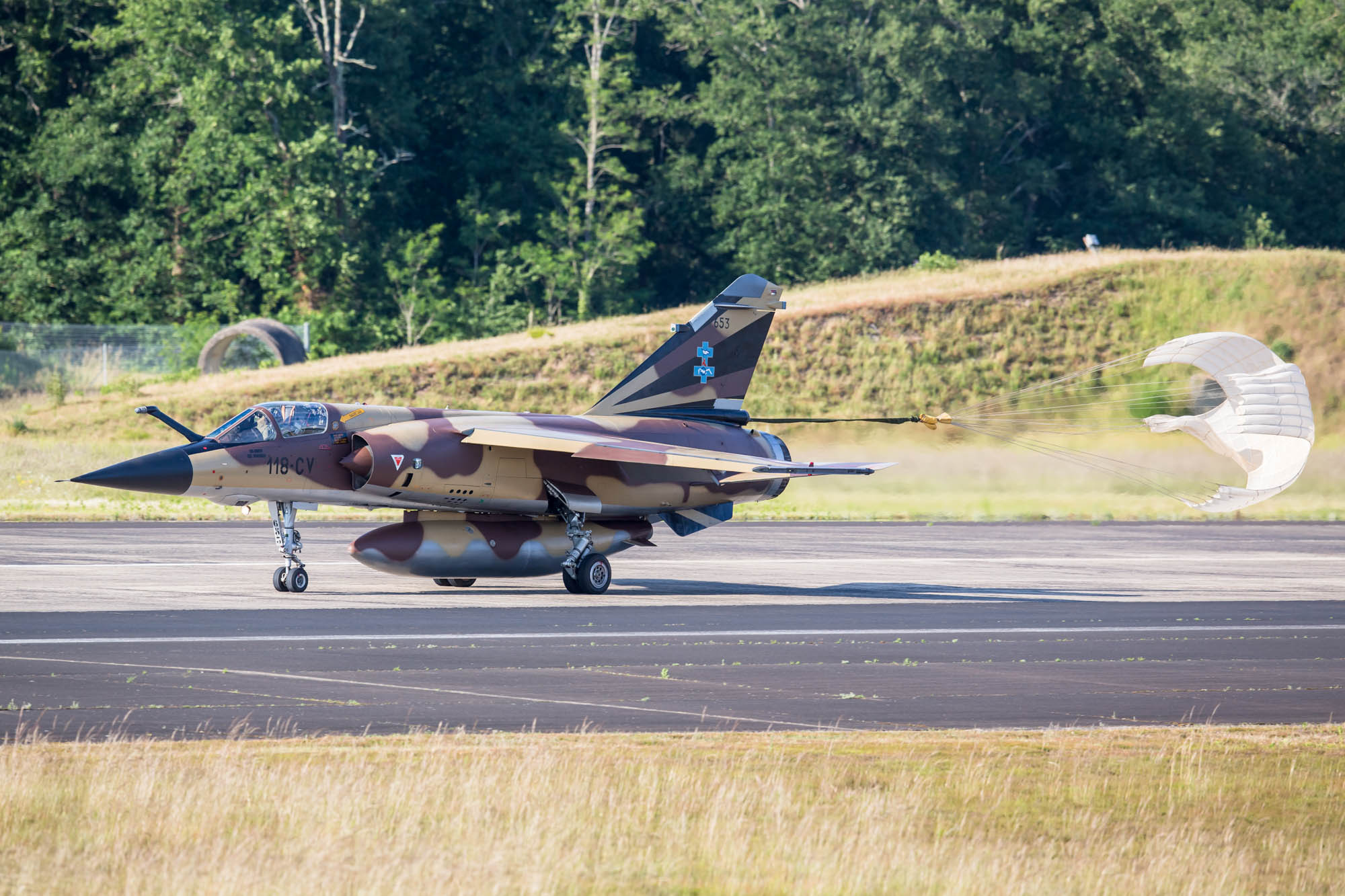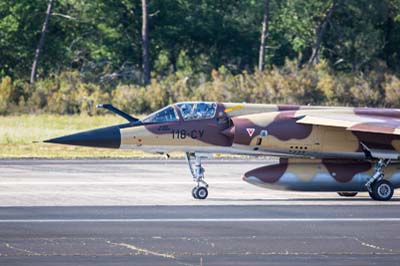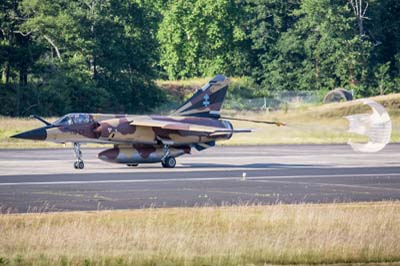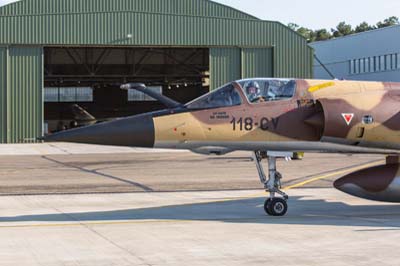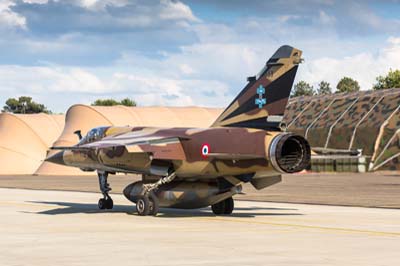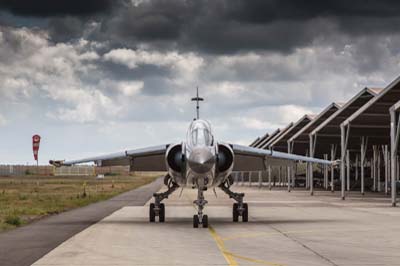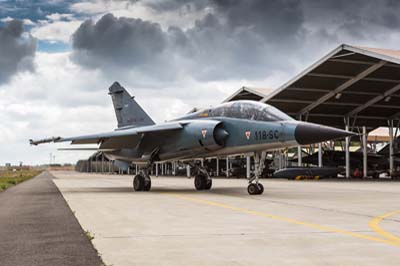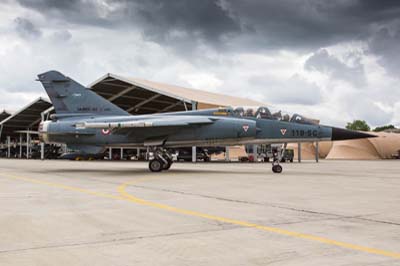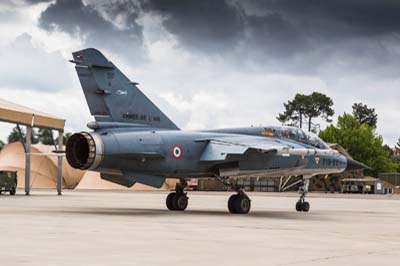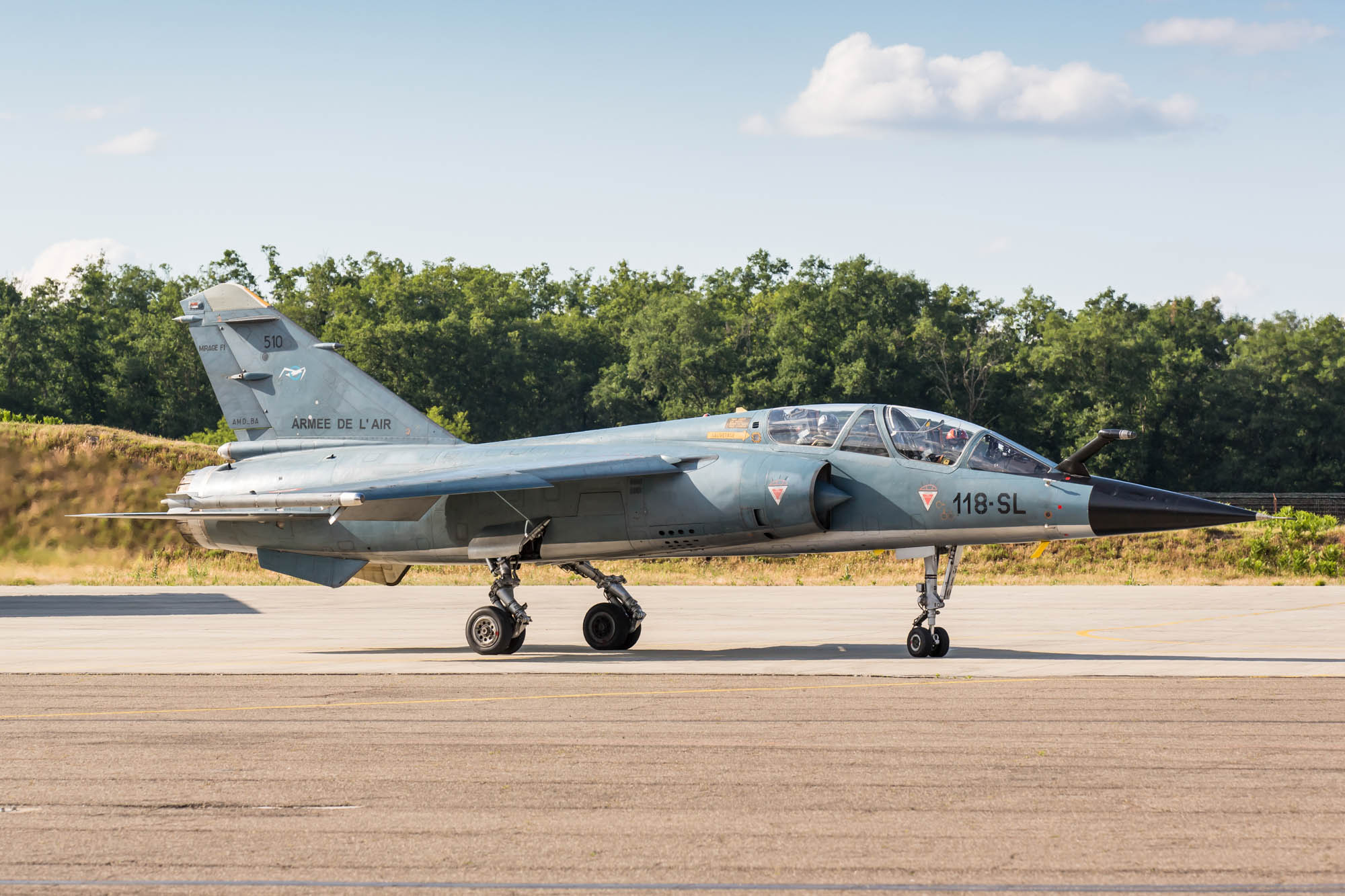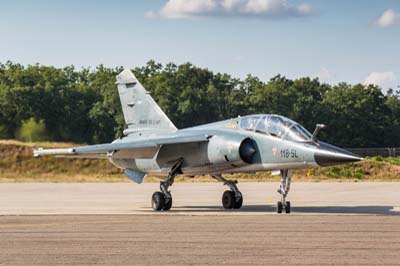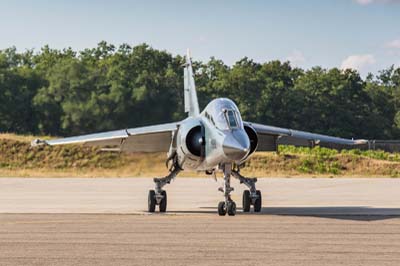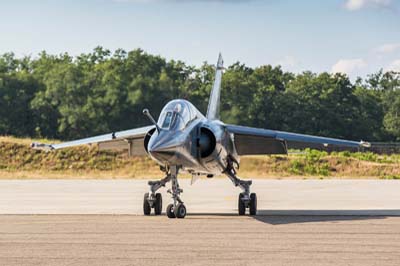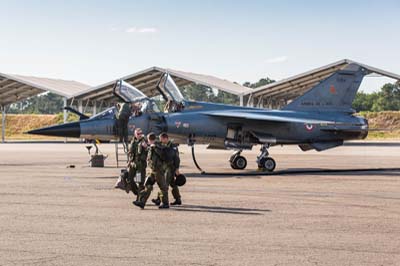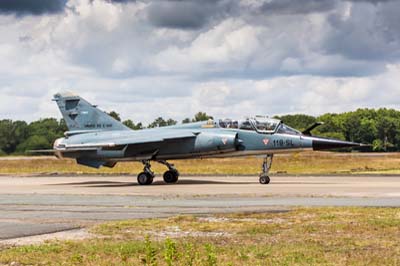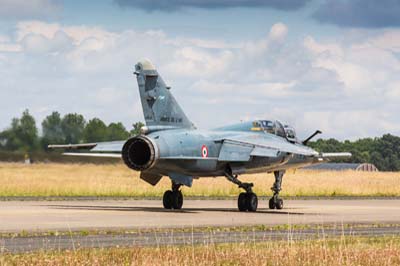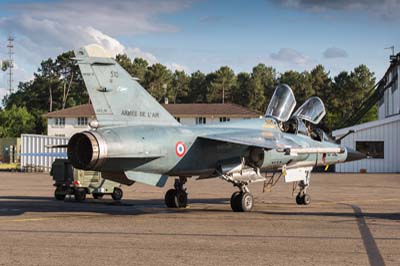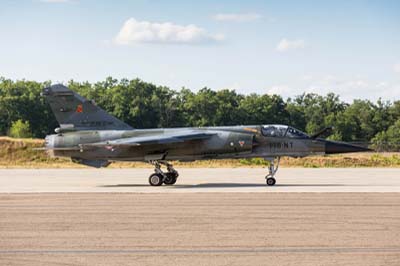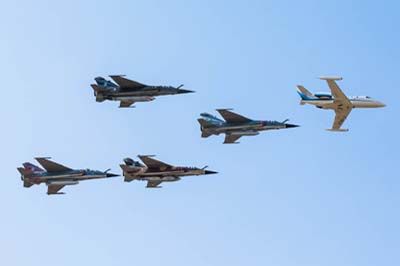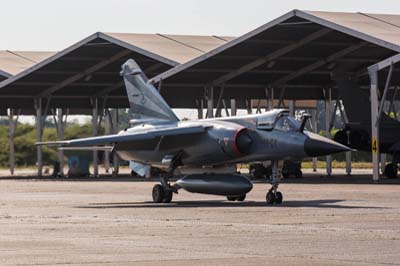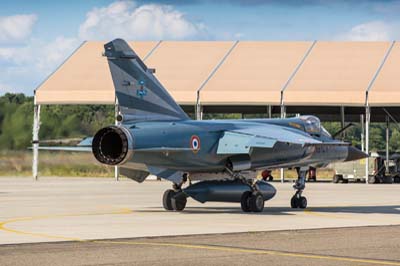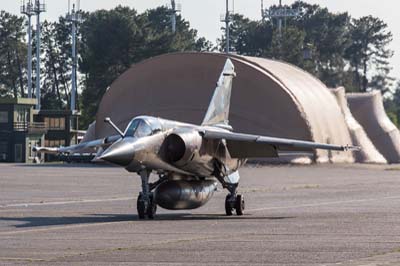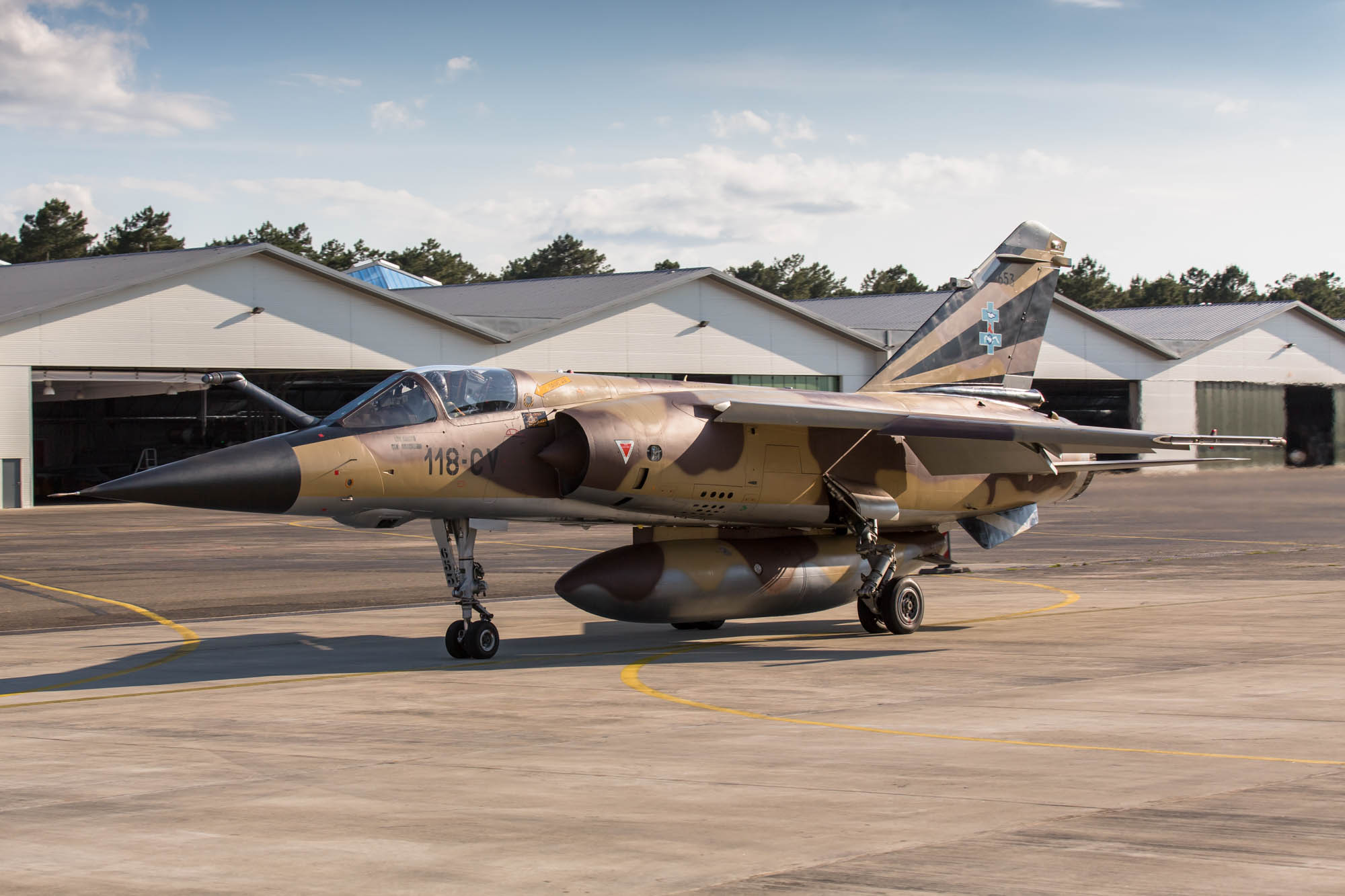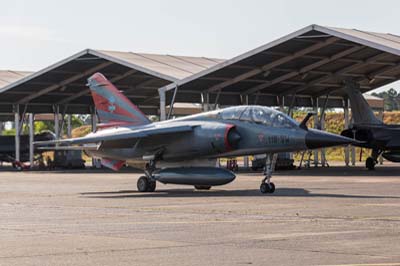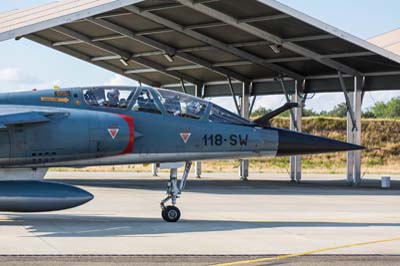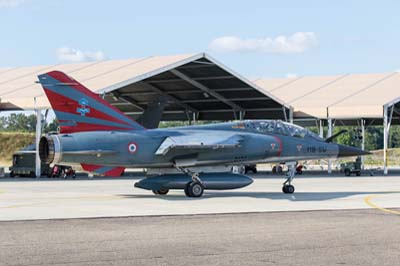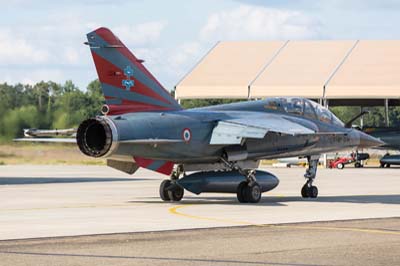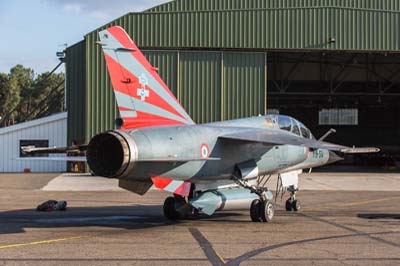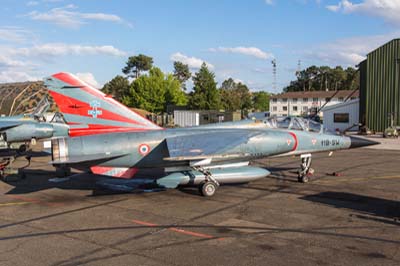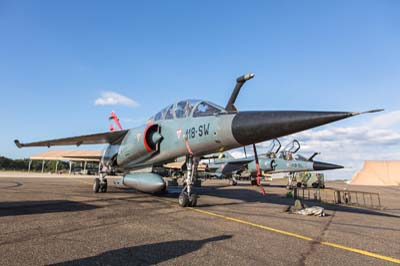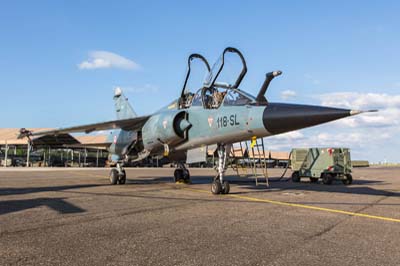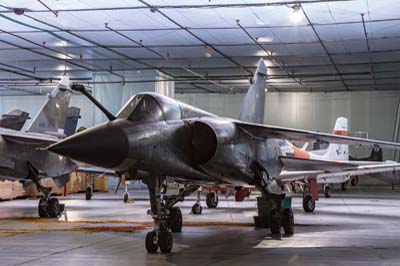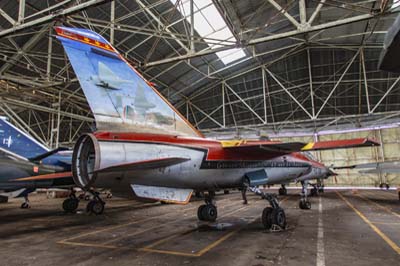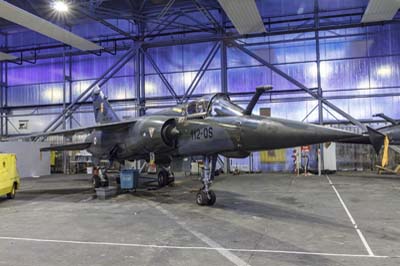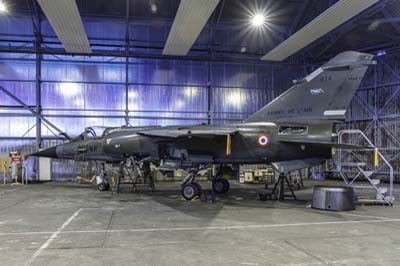French Air Force - Armée de l'Air
Flying the Fox One - The Mirage F.1 retires
Mont de Marsan (BA 118)
May 2014
|
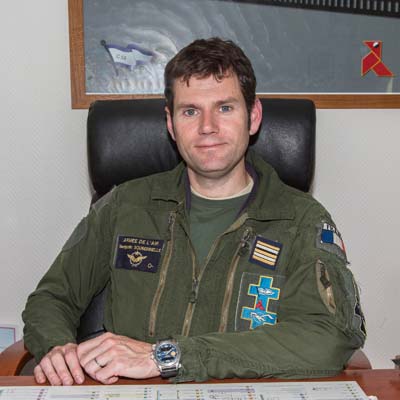 |
Lieutenant-Colonel Benjamin Souberbielle, Commander of ER 2/33 Squadron spoke of a close family connection (or tradition) he has with the Mirage F.1 and ER 2/33 squadron; “My grandfather was a fighter pilot, a recce’ pilot like me, he was also a former commander of 2/33 back in 1961. He also flew the ‘Fox One’ towards the end of his flying career and later became a General”. Lt.Col Souberbielle will transfer to the Canadian Forces Aerospace Warfare Centre after ER 2/33 disbands he also remarked; “It’s a strange feeling knowing you are flying the aircraft my grandfather flew, although the ‘Fox One’ we fly today is not the same aircraft of the 1970s”. He admitted what he will miss the most will be flying over desert and high mountains, which is the best part of the job. |
The end of a tradition
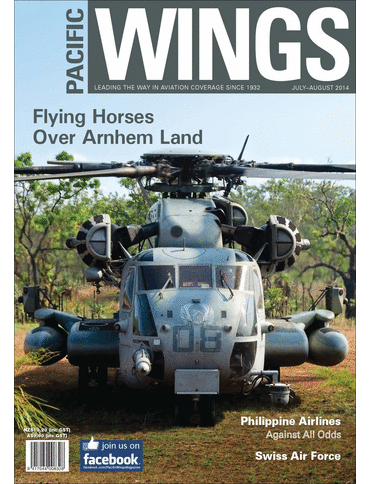 Philip Stevens for Pacific Wings reports: Escadron de Reconnaissance 2/33 (ER 02.033) named ‘Savoie’ is the last Armée de l'Air (Adl’A - French Air Force) squadron to fly the Mach 2+ capable Dassault Mirage F.1. The ‘Fox One’ as it is affectionately called throughout the squadron has a primary mission of tactical reconnaissance and a secondary mission of ground-attack. On June 13, 2014 ER 2/33 at Base Aérienne (BA) 118 Mont de Marsan celebrated the retirement of their 40 year old designed jets and their disbandment. ER 2/33 will still fly up till July 14 when six of their aircraft will take part in the Bastille Day fly past over Paris before descending for the last time in to the French Air Force’s storage centre (Entrepôt de l'Armée de l'air 601 - EAA 601) at Chateaudun.
Philip Stevens for Pacific Wings reports: Escadron de Reconnaissance 2/33 (ER 02.033) named ‘Savoie’ is the last Armée de l'Air (Adl’A - French Air Force) squadron to fly the Mach 2+ capable Dassault Mirage F.1. The ‘Fox One’ as it is affectionately called throughout the squadron has a primary mission of tactical reconnaissance and a secondary mission of ground-attack. On June 13, 2014 ER 2/33 at Base Aérienne (BA) 118 Mont de Marsan celebrated the retirement of their 40 year old designed jets and their disbandment. ER 2/33 will still fly up till July 14 when six of their aircraft will take part in the Bastille Day fly past over Paris before descending for the last time in to the French Air Force’s storage centre (Entrepôt de l'Armée de l'air 601 - EAA 601) at Chateaudun.
Lieutenant-Colonel Benjamin Souberbielle, commander of 2/33 since September 2013 has more than 1,500 hours on the Mirage F.1 speaking before the June 13 event said; “We have strong feelings of nostalgia about the retirement. All the pilots in the squadron are really proud to be the last to fly the ‘Fox One’ in the French Air Force”.
Retired Mirage F.1 pilots were invited to the event; “We want the former pilots to be proud of what we are doing now” said Lt.Col. Souberbielle. He explained that four of his aircraft were specially painted to represent all the Mirage F.1 standards flown over the years; the blue for the air defence and their current operations, the green camouflage for reconnaissance, sand camouflage for operations in Africa and a Mirage F.1B twin seat.
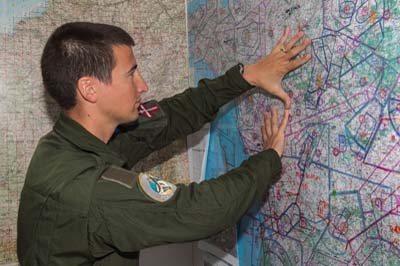 |
Traditional methods
Captain Antoine Crepy, callsign ‘Today’ demonstrates more traditional or basic methods of flight planning; “Once we have our task and objectives we roughly compute fuel consumption using our hands. We know for the ‘Fox One’ with wing tanks and flying at low-level that one hand represents 500 litres of fuel. So with 6,400 litres of fuel down to our minimum of 1,100 litres we have a range at low-level of roughly ten hands”. |
Less than two years ago EC 2/33 celebrated their 100th anniversary as it was formed in 1912 as the French Army Aviation 6th Escadrille (Flight) to fly the Salmson. Designated ‘SAL 6’ the tradition continues to this day with it’s emblem of a white Rhine gull within a blue circle designed at a time when they were flying reconnaissance flights over the German Rhineland in 1920, making it the third oldest reconnaissance squadron in the world. It is feared that EC 2/33 will not be reformed in the future particularly as dedicated reconnaissance squadrons are phased out due to the introduction of multi-role aircraft such as the Dassault Rafale.
ER 2/33s Mirage F.1CRs are the only variant still flying it was the last French aircraft specifically designed for the reconnaissance role with its integrated cameras and sensors. Another tradition to end is the old system of processing wet film after every reconnaissance sortie. The Rafale can utilise the latest external reconnaissance pods when required and records images digitally transmitting the data to ground stations in real time.
After forty years
The Dassault Mirage F.1 was designed as a single-seat air-superiority and all-weather fighter and a successor to the Dassault Mirage III. The prototype first flew on December 23, 1966 and was accepted by the Adl’A in May 1967. The Mirage F.1C entered service in May 1973, initially armed with just two 30mm internal cannon. In 1976 the R530 medium-range air-to-air missile was introduced followed by the R550 Magic air-to-air missile a year later. Initially 103 F.1Cs were supplied followed by 83 F.1C-200s between 1977 and 1983, 55 of these were later converted to F.1CT standard for the ground attack role. In 1980 20 two-seat F.1Bs were introduced as an operational conversion trainer. In December 1982 the first of 64 Mirage F.1CRs designed primarily for the tactical reconnaissance role, were added to the fleet. Mirage F.1 production reached 720 aircraft which were supplied to the air forces of; Ecuador, Spain, Greece, Iraq, South Africa, Libya, Kuwait, Jordan, Qatar and Morocco. |
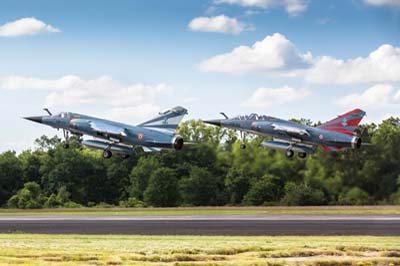 |
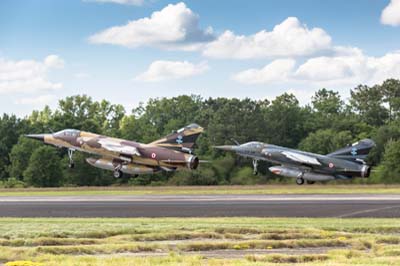 |
| Left to right: Mirage F.1CR (660 '118-CY' with Mirage F.1B (502 '118-SW') and Mirage F.1CRs (653 '118-CV' with 611 '118-NM'). |
Operations abroad
Lieutenant-Colonel Julien Moreau is now the Commanding Officer (CO) of the Advanced Jet Training School (AJeTS) at BA 705 Tours-St. Symphorien. In seven years he clocked up 1,500 hours on the Mirage F.1CT. With regular tours of duty to North Africa he flew mostly Close Air Support (CAS) missions and recalled his time flying the ‘Fox One’.
In the Central African Republic the rules of engagement were; a show of force before employing weapons, initially as a warning. Weapons could only be used for self-defence extending to protect troops on the ground. For anything else you needed approval from the JFAC (Joint Force Air Commander) at our operational base at N'Djamena in Chad.
Lt Col Moreau recalled, “It was often difficult to identify a target during CAS operations and distinguishing our own ground forces from those that wished them harm”. During one such conflict a village supported combined French and Central African Republic forces was under threat by the rebels to the north. A Bréguet ATL-2 Atlantique had been on station above the area all night. Lt Col Moreau continues; “We were called in at first light, to identify the target took some time, the ground was a desert scrubland. We were at 10,000 feet (3,048m) AGL. The AFAC (Airborne Forward Air Controller) in the Atlantique cleared us for a show of force. We rapidly descended to five miles (8 km) from the point for the run in. The show of force was reported to have had no effect so the next pass was a bombing run as directed by the JTAC (Joint Terminal Attack Controller) on the ground. A benefit of using a show of force first is that identification of the target is very difficult in that environment, the FAC will advise you on the radio ‘right overhead’ which gives you further confidence that you know where the target is”.
|
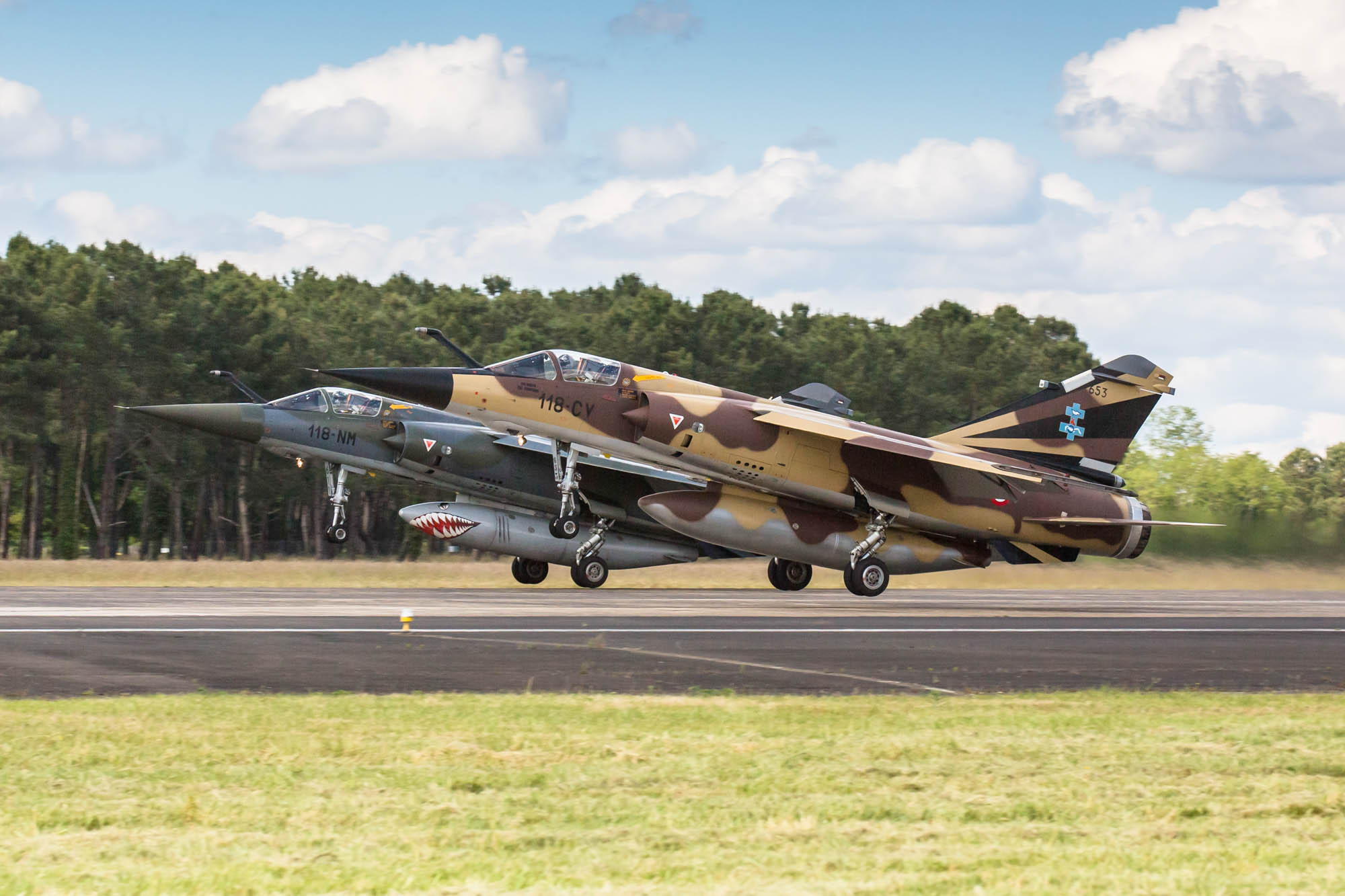 |
| Mirage F.1CRs (653 '118-CV' with 611 '118-NM'). The Mirage F.1 has internal fuel tanks with a capacity of 4,100 litres, it can carry a pair of 1,200 litre known a 'Little Fox' tanks under the wings or a massive 'Big Fox' tank held under the fuselage with a capacity of 2,300 litres. The 'Big Fox' was designed for the Iraqi Air Force but were not delivered due to an embargo. The single tank enables four bombs to be carried under the wings as opposed to just two. However the aircraft is then very heavy making handling very difficult especially as the tank does not have internal compartments to stop the fuel moving around which makes air to air refuelling a challenge. |
Finding out your fate
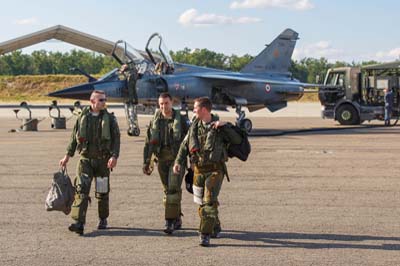 |
ER 2/33 Mirage F.1 pilots walking back to the crew room after their training sortie. |
Capt Antoine Crepy, a career officer with ER 2/33 and a qualified two-ship lead flying the ‘Fox One’, was hoping to move on to the Rafale. He eventually had to accept that the austerity cuts or "crisis" would play a big part in his future as he left the November 2013 interview with an HR Officer from CFA (Command Force Aérienne or Air Force Command). “He told me that I did not have the right profile for the Rafale or for the Mirage 2000C and Mirage 2000 dash 5, as I did not know enough about air defence. The Mirage 2000N would have been possible but they are now phasing out the crews to prepare for the Rafale. They are already sending crew to train on the Rafale, so that was not an option”. The Mirage 2000D could have been an option but Capt Crepy was informed that there was a surplus of pilots of his generation with two-ship lead qualifications.
In April 2014 Capt Crepy was told of his fate, he was going to the Ecole de transition Opérationnelle (ETO 008) with AJeTS at BA 120 Cazaux as an instructor on the Dassault-Dornier Alpha Jet E; “I felt good that I was going to Cazaux, because at first it was proposed that I become an instructor at Salon-de-Provence”. BA 701 Salon-de-Provence is the French Air Force flying school (Ecole Militaire de L’AdlA) and is equipped with the Socata TB-10 Tobago, Cirrus SR20 and SR22. Speaking of these propeller powered basic trainers he continued; “They are not quick enough I wanted a jet even an Alpha Jet. I started on the Mirage F.1 in 2011 believing I would transfer to the Rafale when it was retired. I do consider myself lucky to fly the ‘Fox One’ I do not regret my choice”.
What will happen to the ‘Fox One’ pilots
All of the pilots of ER 2/33 were individually told of where their future in April, only three would make it to the Rafale while some would end their flying career when the squadron disbands. Capt Damien Eymann with 1,500 hours on Mirage F.1 will transfer to the United Arab Emirates (UAE) for three years. As a Mirage F.1 display pilot he will fly Nancy and Cazaux and also in the Bastille Day fly past. “I am sad my time is ending here, I flew the ‘Fox One’ for more than eight years I will perhaps never fly a jet fighter again. After UAE I will return as an instructor either at Salon-de-Provence, Tours or Cazaux”. He spoke fondly of his aircraft; “I like the ‘Fox One’ most of all because it is a single seat, I like the profile of a fighter pilot alone in his aircraft”. He continued; “I will remember air to air refuelling, with the ‘Fox One’ it is a kind of sport requiring a lot of skill”. Recalling his time during ‘Operation Unified Protector’ Capt Eymann said; “The real threat over Libya was flying a single engine jet with a limited availability of air to air refuellers (AAR) and big distances to cover over sea. We expected ground to air threats which did not materialise; the biggest threat was engine failure over Libya and being captured by Al-Qaida”.
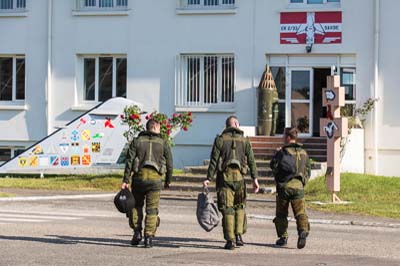 |
Three pilots walk back to the ER 2/33 'Savoie' Operations building for almost the last time. Outside amongst other relics is a Mirage F.1 tail displaying the emblems of previous 'Fox One' squadrons. |
Capt Corentin Le Nir also has 1,500 hours on Mirage F.1 and is to go to Cazaux as instructor on the Alpha Jet. He likes the Mirage’s small cockpit, long nose and small wings. “The ‘Fox One’. is a beautiful aircraft but with its small wings it was not easy to fly in the hot weather of Africa. I will remember the operations abroad, in Afghanistan and Africa. The environments were different; Afghanistan was very dangerous on the ground, long missions with a lot of AAR over hostile territory and big mountains”. Over Libya there were no friendly forces on the ground, “We flew between 10,000 feet and 20,000 feet, at 10,000 feet it is dangerous but the lower you are the better the picture. We flew over Tripoli at 10,000 feet looking for military bunkers, command centres and air bases”.
Capt Crepy is also predictably fond of his aircraft, “I love the ‘Fox One’ because it does not have a computer between me and the controls I know if it enters a spin it is my fault. The cockpit is very small, it fits like a glove you feel everything”. Looking back at his time flying the Mirage F.1CR he recalled operations in Africa, “I was on the last Chad detachment once was called in by a special forces FAC to make some noise to deter [rebel forces], I had to fire the gun which I will have in my mind all my life”.
As one of the younger upcoming members of the squadron Capt Tomas Trevidic was acknowledged as being an exceptional pilot. He described when he found out two months ago that he was transferring to the Rafale. “The Chief of Operations called me into his office to tell me I was going to St.Dizier to fly the Rafale with EC 01.091 Squadron. I was excited to walk into the crew room I had to buy beers. When I qualify here on the ‘Fox One’ to fly two-ship lead I will buy Champagne”. To qualify Capt Trevidic has two training flights, a four ship package and a two versus one Air Combat Manoeuvres (ACM) sortie. These are followed by five qualification flights comprising; a reconnaissance, strike, two versus one Combat Air Support (CAS) sortie and one instruction flight. He will keep his two-ship lead qualification on the Rafale after training flights during the first two or three months after conversion training. He expects to be on the Rafale in the nuclear strike role until 2019. Capt Trevidic admitted, “You have to face the truth the ‘Fox One’ is an old aircraft, it is a good aircraft in a low intensity war, but you can see in a high intensity war environment and in international exercises such as Frisian Flag and the TLP (Tactical Leadership Program) it has become hard for us to get the SA [situational awareness] as we don’t have Link 16 communications and our Radar is poor”.
|
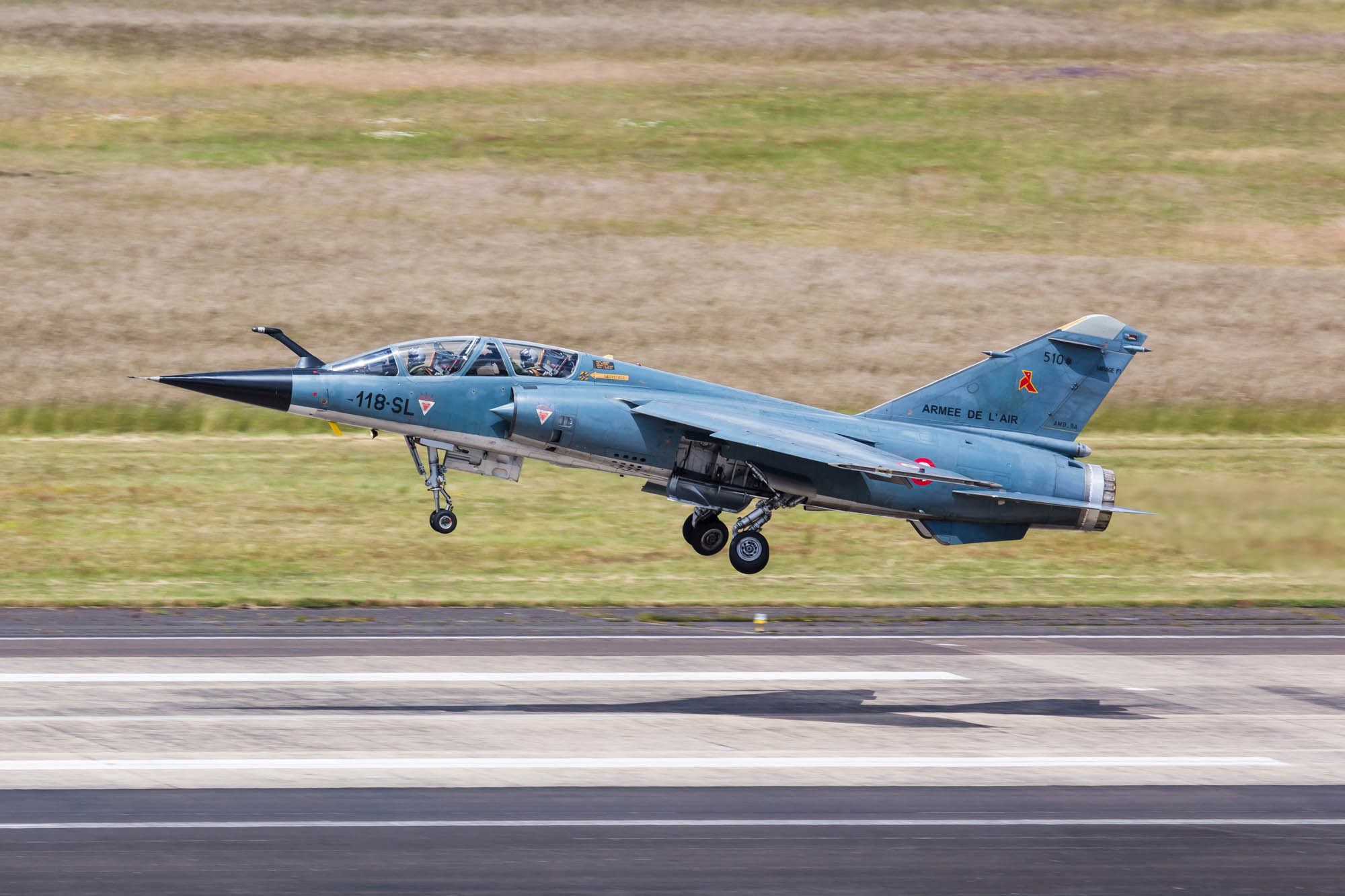 |
Two-seat Mirage F.1B (510 '118-SL') departing Mont de Marsan, it may be one of the two-seats sought by the Royal Morocco Air Force.
ATAC acquired several of these Mirage F1s, including 510, which was registered N604AX. |
In conclusion
The final Mirage F.1CR flights will be for the impressive Bastille Day flypast which will include the four specially painted aircraft before returning to Chateaudun and so end the Mirage F.1s flying days with the French Air Force. The Mirage F.1 however is still flown by a few other countries air forces, notably Morocco, who it have apparently expressed an interest in acquiring three of the Mirage F.1B two-seats to be based at Meknes a former French Air Force base (BA708). The Royal Moroccan Air Force has around 50 Mirage F.1CH and F.1EH and nearly 30 Mirage MF2000s a version introduced in 2006 and using Mirage F.1s upgraded by SAGEM and Thales. The consortium added the Damocles laser designation pod, the air-to-ground AM-39 Exocet missiles, air-to-air missiles MICA IR and Magic II missiles and the AASM guided bombs, a more powerful engine and radar with improved avionics. The Royal Moroccan Air Force Mirage F.1 should live on for some years to come.
Mirage F.1 Production for the French Air Force:
Mirage F.1C (serials 01-04, 01, E01 and 1-103) delivered from May 1973.
Mirage F.1C-200/F.1CT (serials 201-283) delivered from 1977 to 1983, 55 were later converted to F.1CT the remainder were withdrawn in 2003.
Mirage F.1B (serials 501-520) delivered from October 1980.
Mirage F.1CR (serials 601-664) delivered from December 1982, the last Mirage F.1CRs were withdrawn after the Bastille day flypast on July 14, 2014. |
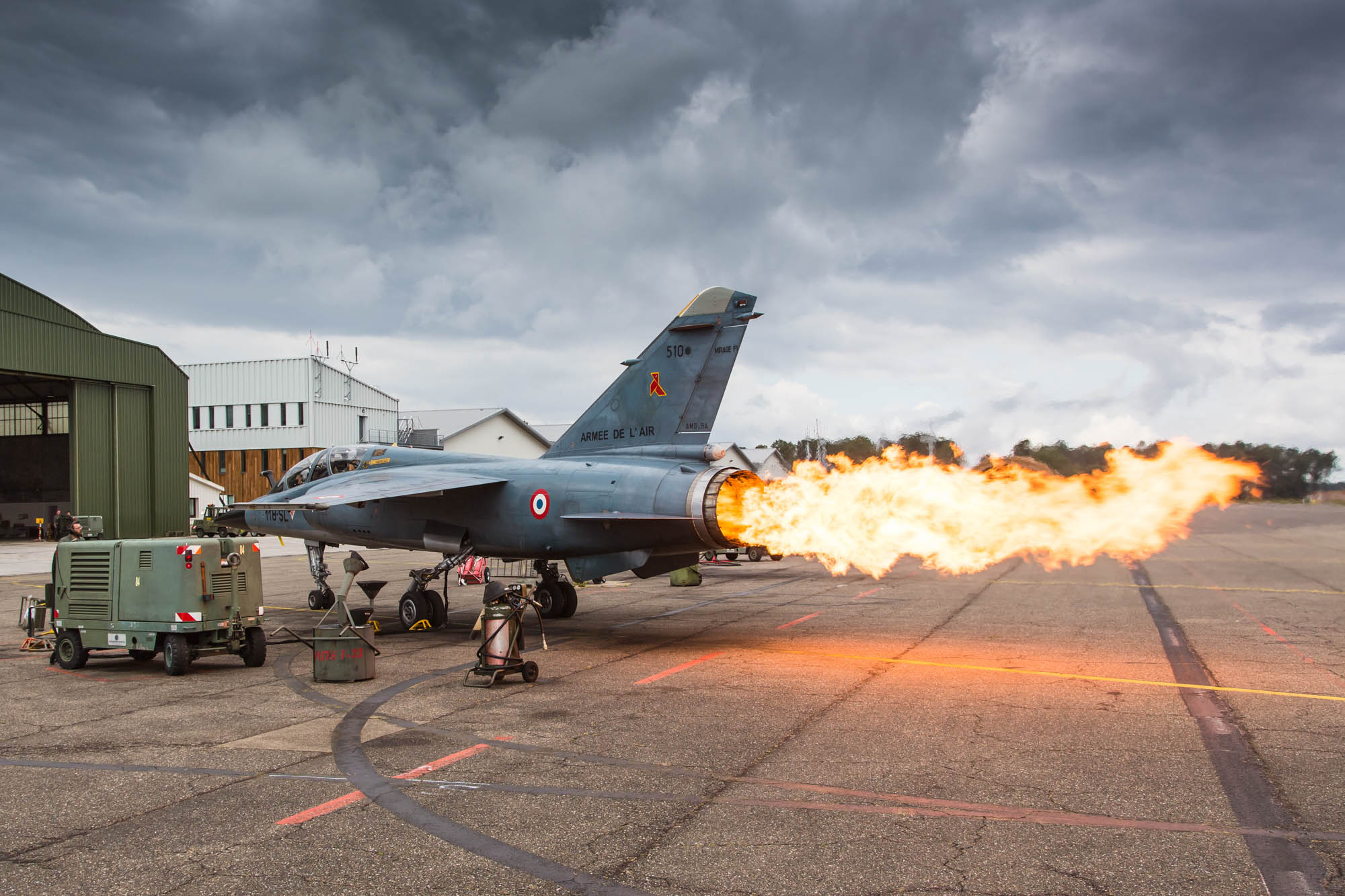 |
| The flame is about to go out. |
| Two-seat Mirage F.1B (511 '118-SL'). It is normal for the Mirage F.1 on engine start-up for flame to come out of the exhaust nozzle caused by an excess of fuel entering the exhaust system where sufficient oxygen causes it to light for a few seconds. |
| Around Base Aérienne 118 Mont de Marsan |
Mirage F.1CR special tails (653 '118-CV', 660 '118-CY' and 611 '118-NM') and Mirage F.1B (502 '118-SW').
The specially painted Mirage F.1s were designed to represent all the Mirage F.1 standards flown over the years; the blue for the air defence and their current operations, the green camouflage for reconnaissance, sand camouflage for operations in Africa and a Mirage F.1B twin seat. |
| All the tails of the specially painted Mirage F.1 carry the Escadron de Reconnaissance 2/33 (ER 02.033) named 'Savoie' cross insignia, with the comprising Escadrilles of SAL.6 'Mouette Rhénane' (Rhine gull in blue circle), BR.11 'Cocotte de gueules' (origami chicken) and C.53 'Fanion' (pennant) upon it. |
| Mirage F.1B (502 '118-SW') |
| Left to right: Preparing Mirage F.1B (511 '118-SL') for flight. |
| Left to right: Undercover Mirage F.1CRs (660 '118-CY', 611 '118-NM', 653 '118-CV' and 654 '118-NC') with its engine removed. |
| Mirage F.1B (517 '118-SC'), it wears the Escadrille BR.11 'Cocotte de gueules' (origami chicken) emblem on the port side of the tail. |
| Left to right: Mirage F.1Bs (517 '118-SC' and 510 '118-SL'). |
| Left to right: Mirage F.1B (510 '118-SL'). |
| Mirage F.1CR (611 '118-NM'). |
| Left to right: Mirage F.1CR (660 '118-CY') and Mirage F.1B (502 '118-SW'). |
| Left to right: Mirage F.1B (502 '118-SW') and Mirage F.1CR (653 '118-CV'). |
| Mirage F.1CR (611 '118-NM') |
| Left to right: Mirage F.1CR (611 '118-NM'). |
| Left to right: Mirage F.1CR (660 '118-CY'). |
| Left to right: Mirage F.1CR (660 '118-CY' with Mirage F.1B (502 '118-SW'). |
| Mirage F.1CR (659 '118-NT') it wears the Escadrille BR.11 'Cocotte de gueules' (origami chicken) emblem on the starboard side of the tail. |
| Left to right: Mirage F.1CRs (653 '118-CV' with 611 '118-NM'). |
| Left to right: Mirage F.1B (510 '118-SL') with Mirage F.1CR (659 '118-NT') heading out for their practice display. |
| Mirage F.1CR (653 '118-CV') chute deployed on landing. |
| Left to right: Mirage F.1CR (653 '118-CV') returning to flightline. |
| Left to right: Mirage F.1B (517 '118-SC') taxiing out from the sun shelter area, it wears the emblem of Escadrilles SAL.6 'Mouette Rhénane' (Rhine gull in blue circle) on the starboard side of the tail. |
| Mirage F.1B (510 '118-SL') it wears the emblem of Escadrilles SAL.6 'Mouette Rhénane' (Rhine gull in blue circle) on the starboard side of the tail. |
| Left to right: Mirage F.1B (510 '118-SL') returning to the flightline. |
| Left to right: Mirage F.1B (510 '118-SL') and Mirage F.1CR (659 '118-NT'). |
| Left to right: Special tail flypast Mirage F.1CRs (653 '118-CV, 611 '118-NM' and 660 '118-CY') with Mirage F.1B (502 '118-SW'). |
| Mirage F.1CR (653 '118-CV') |
| Left to right: Mirage F.1B (502 '118-SW'). |
| Left to right: Mirage F.1B (502 '118-SW') with Mirage F.1B (510 '118-SL'). |
| Mirage F.1s In storage at Châteaudun |
Left to right: Mirage F.1CT (274 '112-QT') of ER 02.033 SAL6 at Mont-de-Marsan (BA 118).
Mirage F.1CR (628 '112-NB') of ER 02.033 in the special scheme of ER 01.033 from its time at Reims-Champagne (BA 112).
Mirage F.1CT (226 '112-QS') of ER 02.033 with an old EC 02.030 emblem on the tail.
Mirage F.1CR (614 '112-NR') of ER 02.033.
with the Entrepôt de l'Armée de l'air 601 (EAA 601) at Base Aérienne 279 Châteaudun in February 2012. |





